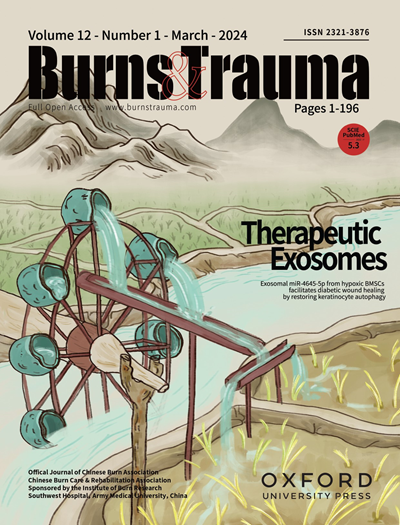Sepsis after Trauma—Evolving Paradigms in Stress Biology and Host Response Failure
IF 9.6
1区 医学
Q1 DERMATOLOGY
引用次数: 0
Abstract
Severe trauma is often complicated by subsequent infection and organ dysfunction, with sepsis being a major mortality risk factor. Factors such as barrier destruction, wound contamination, invasive procedures, injury severity, and shock were traditionally considered primary predisposing elements for post-trauma sepsis. However, recent advances in stress biology have revealed a more nuanced understanding of the body's response to trauma. Organisms have evolved adaptive responses to various noxious stimuli that follow a biphasic pattern: Low to moderate stress levels can increase resilience, while overwhelming insults, both acute and chronic, overstrain the body’s coping mechanisms and are known as allostatic overload, hallmarked by maladaptive responses. An illustrative example of this concept is the body's response to iron ion exposure following trauma, transfusion, or haemolysis. Iron ions, at low levels, induce adaptive Nrf2-dependent responses, such as haem oxygenase gene expression. However, high concentrations or prolonged exposure can lead to cellular damage and organ failure, e.g. through the production of highly reactive free radicals. This biphasic pattern highlights the complex interplay between protective and harmful responses in post-trauma physiology. Whereas tools such as the SOFA score allow to measure severity of organ dysfunction, no metrics for quantifying the intensity of "stress" over time are available. As cumulative stress is a crucial outcome-associated factor in trauma care, the development of adequate indicators could significantly enhance our understanding and management of post-trauma complications, arising from secondary surgical interventions, transfusion management or metabolic derangements. This evolving perspective on stress biology in the severely injured host underscores the need for a more comprehensive approach to patient assessment and treatment in critical care settings, to identify and to decrease stress load with the aim to prevent life-threatening complications, such as sepsis, and ultimately improve outcomes.创伤后败血症:应激生物学和宿主反应失败的进化范式
严重创伤往往并发感染和器官功能障碍,败血症是主要的死亡危险因素。屏障破坏、伤口污染、侵入性手术、损伤严重程度和休克等因素传统上被认为是创伤后败血症的主要诱发因素。然而,压力生物学的最新进展揭示了对身体对创伤反应的更细致的理解。生物体已经进化出适应各种有害刺激的反应,这种反应遵循双相模式:低到中等的压力水平可以增加恢复力,而压倒性的侮辱,无论是急性还是慢性,都会使身体的应对机制过度紧张,被称为适应过载,以适应不良反应为特征。这个概念的一个说明性例子是身体对创伤、输血或溶血后铁离子暴露的反应。铁离子,在低水平,诱导适应性nrf2依赖性反应,如血红素加氧酶基因表达。然而,高浓度或长时间接触可导致细胞损伤和器官衰竭,例如通过产生高活性自由基。这种双相模式强调了创伤后生理学中保护性和有害反应之间复杂的相互作用。虽然诸如SOFA评分之类的工具可以测量器官功能障碍的严重程度,但没有量化长期“压力”强度的指标。由于累积应激是创伤护理中一个关键的结果相关因素,因此制定适当的指标可以显著提高我们对创伤后并发症的理解和管理,这些并发症是由二次手术干预、输血管理或代谢紊乱引起的。这种对严重受伤宿主应激生物学的不断发展的观点强调了在重症监护环境中需要更全面的患者评估和治疗方法,以识别和减少应激负荷,以防止危及生命的并发症,如败血症,并最终改善结果。
本文章由计算机程序翻译,如有差异,请以英文原文为准。
求助全文
约1分钟内获得全文
求助全文
来源期刊

Burns & Trauma
医学-皮肤病学
CiteScore
8.40
自引率
9.40%
发文量
186
审稿时长
6 weeks
期刊介绍:
The first open access journal in the field of burns and trauma injury in the Asia-Pacific region, Burns & Trauma publishes the latest developments in basic, clinical and translational research in the field. With a special focus on prevention, clinical treatment and basic research, the journal welcomes submissions in various aspects of biomaterials, tissue engineering, stem cells, critical care, immunobiology, skin transplantation, and the prevention and regeneration of burns and trauma injuries. With an expert Editorial Board and a team of dedicated scientific editors, the journal enjoys a large readership and is supported by Southwest Hospital, which covers authors'' article processing charges.
 求助内容:
求助内容: 应助结果提醒方式:
应助结果提醒方式:


